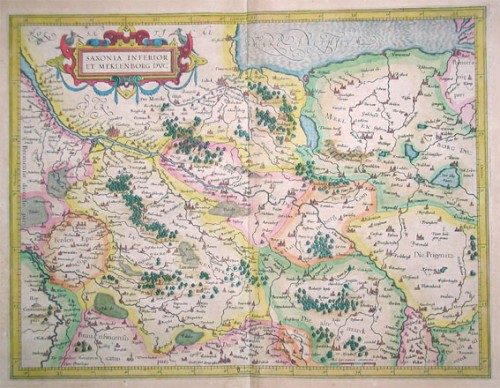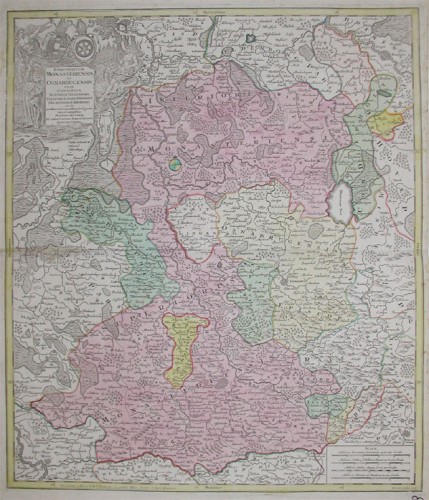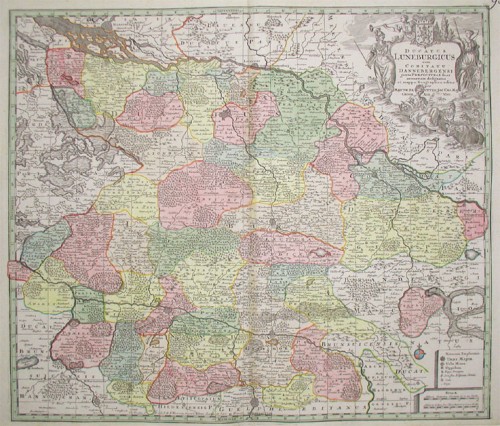Homann, Johann Baptist
Ducatus Bremae et Ferdae Nova Tabula edita á Ioh. Bapt. Homanno Norimbergae cum Privilegio Sac. Caes. Majest.
Eigenschaften
- Published: Homann , Nürnberg
- Published date: 1720
- Technique: Copper engraving / Original color.
- Type: Antique Map, map
- Issue date: 1720
- Category: Bremen & Verden
- Size: 486 by 567mm (19 by 22 inches).
- Stock number: 20502
- Condition: In excellent condition. Published plano without a centre fold. 486 by 567mm (19 by 22 inches).
Article description
Article description
Original antique copper engraving, hand colored in outline and wash when published. Zeigt die beiden Herzogtümer Bremen und Verden unterteilt in die einzelnen Ämter. Die wichtigsten Straßen sind eingezeichnet. Zahlreiche Dörfer und Siedlungen sind neben den größeren Städten vermerkt. Unten links ist der Meilenzeiger eingraviert. In der oberen rechten Ecken ist die unkolorierte prachtvoll drapierte Titelkartusche die von Putti getragen wird. Zwei weitere Putti tragen die Wappen von Bremen und Verden. Zwei Flußgötter für Elbe und Weser runden die Kartusche ab. Das Herzogtum Bremen war 1648 als weltliches Reich aus dem ehemaligen Erzbistum Bremen und dem Hochstift Verden gebildet worden. Die Karte zeigt das Reichsterritorium unter hannöverscher Herrschaft. Shows the two duchies of Bremen and Verden divided into the individual offices. The mileage indicator is engraved in the lower left. In the upper right corner is the uncoloured, splendidly draped title cartouche which is carried by Putti. Two other putti hold the coats of arms of Bremen and Verden. The two river gods for the Elbe and Weser. The Duchy of Bremen was formed in 1648 as a secular empire from the former Archdiocese of Bremen and the Verden monastery. The map shows the imperial territory under Hanoverian rule. Johann Baptist Homann (20 March 1664 – 1 July 1724) was a German geographer and cartographer, who also made maps of the Americas. Homann was born in Oberkammlach near Kammlach in the Electorate of Bavaria. Although educated at a Jesuit school, and preparing for an ecclesiastical career, he eventually converted to Protestantism and from 1687 worked as a civil law notary in Nuremberg. He soon turned to engraving and cartography; in 1702 he founded his own publishing house. Homann acquired renown as a leading German cartographer, and in 1715 was appointed Imperial Geographer by Emperor Charles VI. Giving such privileges to individuals was an added right that the Holy Roman Emperor enjoyed. In the same year he was also named a member of the Prussian Academy of Sciences in Berlin. Of particular significance to cartography were the imperial printing privileges (Latin: privilegia impressoria). These protected for a time the authors in all scientific fields such as printers, copper engravers, map makers and publishers. They were also very important as a recommendation for potential customers. In 1716 Homann published his masterpiece Grosser Atlas ueber die ganze Welt (Grand Atlas of all the World). Numerous maps were drawn up in cooperation with the engraver Christoph Weigel the Elder, who also published Siebmachers Wappenbuch. Homann died in Nuremberg in 1724. He was succeeded by his son Johann Christoph (1703-1730). The company carried on upon his death as Homann heirs company, managed by Johann Michael Franz and Johann Georg Ebersberger. After subsequent changes in management the company folded in 1852.[1] The company was known as "Homann Erben", "Homanniani Heredes", or "Heritiers de Homann" abroad. (Wikipedia) Recently viewed products






